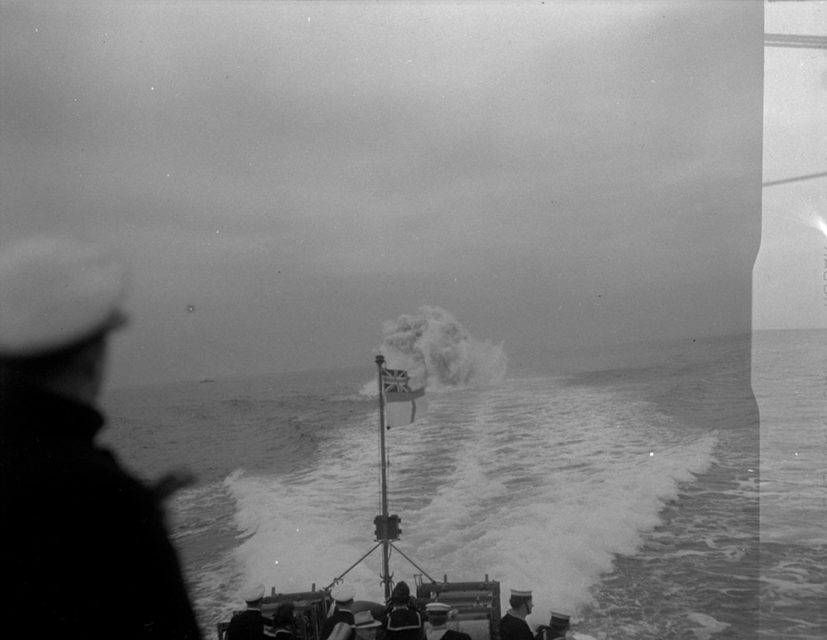Editor’s Note: This series was originally published by Alex Funk on the TimeGhostArmy forums (original URL – https://community.timeghost.tv/t/canada-and-the-battle-of-the-atlantic-part-3/1442).
Sources:
- Far Distant Ships, Joseph Schull, ISBN 10 0773721606 (An official operational account published in 1950, somewhat sensationalist)
[Schull’s book was published in part because the funding for the official history team had been cut and they did not feel that the RCN’s contribution to the Battle of the Atlantic should have no official recognition. It is very much an artifact of its era, and needs to be read that way. A more balanced (and weighty) history didn’t appear until the publication of No Higher Purpose and A Blue Water Navy in 2002, parts 1 and 2 of the Official Operational History of the RCN in WW2, covering 1939-1943 and 1943-1945, respectively.]- North Atlantic Run: the Royal Canadian Navy and the battle for the convoys, Marc Milner, ISBN 10 0802025447 (Written in an attempt to give a more strategic view of Canada’s contribution than Schull’s work, published 1985)
- Reader’s Digest: The Canadians At War: Volumes 1 & 2 ISBN 10 0888501617 (A compilation of articles ranging from personal stories to overviews of Canadian involvement in a particular campaign. Contains excerpts from a number of more obscure Canadian books written after the war, published 1969)
- All photos used exist in the Public Domain and are from the National Archives of Canada, unless otherwise noted in the caption.
I have inserted occasional comments in [square brackets] and links to other sources that do not appear in the original posts. A few minor edits have also been made for clarity.
Earlier parts of this series:
Part 7 — The end of 1940, rise of the U-boat threat, the corvette waddles into the war, and expansion headaches at every turn
In North Atlantic Run, Marc Milner outlines some of the challenges being faced by the escort fleet in the changing conditions of the Battle of the Atlantic:
The fall and winter of 1940-1 was a peculiar time for escort operations, and pre-war concepts of trade defence and ASW were under strain. Losses to convoys were high, and authorities were baffled about effective countermeasures. There was a strong lobby within the RN, supported by Churchill while he was First Lord of the Admiralty and after he became prime minister, that favoured offensive action against U-boats by even the slenderest of escorts. The two schools of thought, one favouring an active pursuit of the enemy and the other the primacy of escort, were still matters for debate when the Canadians joined the Clyde Escort Force in late 1940. Through the winter the issue was finally resolved in favour of defence as the first priority. However, in light of the subsequent Canadian tendency to pursue even the most tenuous contacts with zeal, it is questionable if this exposure to nascent British escort tactics did the RCN much good. … By January all the River-class ships and four of the Towns — two having been held back by defects — were operating from the Clyde. During this second winter of the war there were also Canadian corvettes in the Clyde Escort Force participating in the crucial battles of the first phase of U-boat pack attacks. These corvettes were actually the ten of their class built in Canada to British accounts. All were completed before the freeze-up of late 1940, and the RCN assumed responsibility for their acceptance from the builders, commissioning into the RN, and manning for passage to the UK. Once in England the ships were to be handed over to the Admiralty. Unfortunately things did not go as planned, and the RCN ended up taking all ten of these corvettes into Canadian service.
The story of the “British” corvettes and their transfer to the RCN is an important one, for it illustrates the kinds of problems the RCN had when dealing with the RN. Because the ships were manned for passage only, their crews were the barest minimum, roughly assembled from spare hands, all of whom were designated for other duties upon completion of the crossing. Personnel from the first corvettes to go, for example, were assigned to HMCS Dominion, the RCN’s depot in Britain [Dominion was designated as a ship for administrative purposes, there was no actual physical vessel]. They were to form a manning pool for the destroyers already on operations in British waters. Those from the later passages were to return immediately to commission new RCN corvettes. All ten “British” corvettes were in the UK by early 1941 (the ships were named after flowers, following the Admiralty practice: Arrowhead, Bittersweet, Eyebright, Fennel, Hepatica, Mayflower, Snowberry, Spikenard, Trillium, and Windflower), but from the outset it proved impossible to obtain the release of their crews. As early as October of 1940, Dominion requested, on behalf of the Admiralty, that the crews of three recently arrived corvettes be allowed to remain aboard until the end of November. Reliefs for destroyer personnel, it was explained, could be drawn from the smaller ships (in the form of a “floating” pool) and the ships turned over to the RN in piecemeal fashion. NSHQ concurred, but no British replacement crews were forthcoming, and the issue remained unresolved. The corvettes, meanwhile, began escort operations with the Clyde force.
By February 1941 the delay in the release of men from the British corvettes began to affect planning of the RCN’s own expansion. Commodore G.C. Jones, RCN, commanding officer, Atlantic Coast (COAC) complained that the men should be returned to Canada before the opening of navigation on the St Lawrence River deluged the navy with new ships. “If our present commitments are to be met,” Jones observed, “it is essential this personnel be available.” He was advised by NSHQ that the matter was under review and that a decision was pending. Yet the issue lingered. In April the Admiralty petitioned the RCN to allow Canadian crews to remain aboard “so as to avoid impairing their efficiency by having to recommision them”. Since the ships were now operational, concern for their efficiency was justifiable. That escorts manned by skeleton crews and lacking many essential stores should have been committed to operations says a great deal about the tremendous need for escorts of any kind. It also suggests that communications between the RCN and RN were not what they should have been.
The misunderstanding over the nature of the RCN’s commitment to the ten British corvettes was to have long and serious repercussions. For the moment, the Admiralty’s concern for the efficiency of escorts operating in the embattled Western Approaches took precedence over all else. The Canadians were advised not to worry about the effect that losing these men would have on the buildup of the RCN’s own forces in the Western Atlantic. “It is considered,” the Admiralty’s signal went on to read, “that present circumstances justify some delay in these becoming effective.” Faced with the inevitable, the RCN acquiesced, so long as the ten corvettes were commissioned HMC ships. The Admiralty agreed and undertook to cover the costs and arrangements for refits, maintenance, and alterations and additions to equipment. The RCN was to look after running costs, pay, victuals, and the like (a similar arrangement existed with other Allied navies that undertook to man British warships fully themselves).
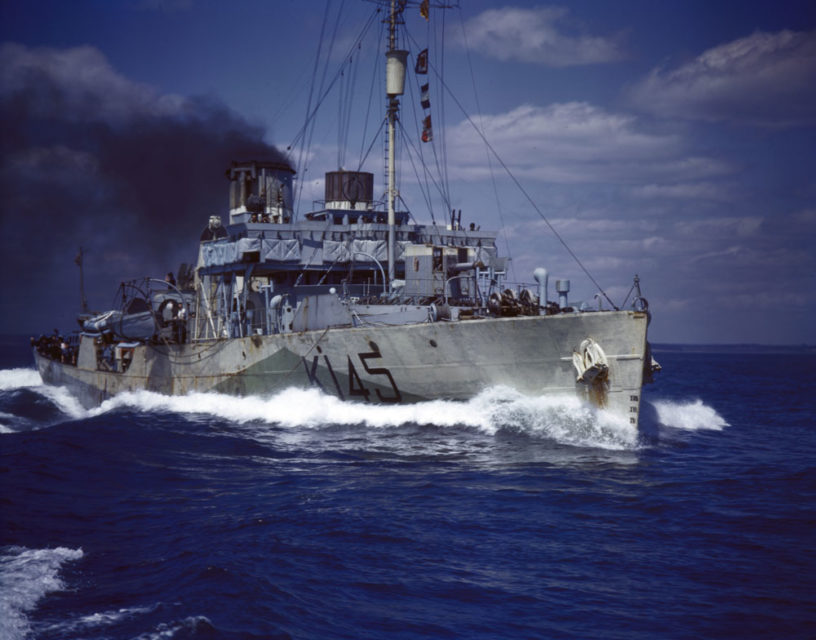
HMCS Arrowhead, one of the ten “British” corvettes built in Canada for the Royal Navy. Photo taken much later in the war, probably 1944-45.
Canada. Department of National Defence / Library and Archives Canada / ecopy
Speaking of the corvettes themselves, the little vessels were 205 feet in length, 33 feet in beam, with a draught of 11.5 feet, a top speed of sixteen knots and a planned armament of one four-inch deck gun, a stock of depth charges, and a lone QF 2-Pounder Pom-Pom gun mounted on the “bandstand” above the engine room, with a planned crew of 80-90 men.
[Editor’s Note: The original design called for a crew about half this size, which translated into terribly overcrowded conditions aboard mid- to late-war corvettes. Adding new weapons, new communications and detection equipment, and miscellaneous additional gear, plus the added food and water for the larger crew meant these little ships were packed as densely as possible.]
Out of necessity, the ships’ armament would grow and change over the years. Many of the original RCN corvettes were also fitted with minesweeping gear. Shortages meant that many would forego the 2-Pounder Pom-Pom, instead receiving two Lewis guns (what these were supposed to do in the event of modern air attack was unknown.) [All allied navies were under-prepared for the risks of air attack early in the war, and it would take time — and significant losses — for that painful lesson to be learned.] Thankfully, most of them would never get within range of Luftwaffe bombers. The few of their own corvettes that the RN assigned to the Mediterranean all received significant anti-aircraft armament augmentation. The use of triple-expansion machinery instead of steam turbines meant the largely reserve/ex-merchant crewmen had an easier time working below. Underwater detection capability was provided by a fixed ASDIC dome; later modified to be retractable. Subsequent technological developments; like the High Frequency Radio Detection Finder or “Huff-Duff” would be added along with a number of different radar systems. More men would be added to crew these systems, putting additional demand on a ship where space was already at a premium.
The Flowers could be serviced by practically any small dockyard or naval station so many ships came to have a variety of different weapons systems and design modifications depending upon when and where they were refitted; there was really no such thing as a “standard” Flower-class corvette. The major changes could include:
- Original twin mast configuration changed to a single mast in front of the bridge, which was then often moved behind the bridge for improved visibility for bridge crew.
- Minesweeping gear removed to improve the ship’s range.
- Galley relocated from the stern to midships.
- Extra depth charge stowage racks added to the stern. Later even more storage was added along the walkways.
- Hedgehog anti-submarine weapons system fitted near the main gun platform.
- Surface radar fitted [in various marks, including some early, relatively primitive Canadian sets or more sophisticated British equipment].
- Forecastle lengthened to midships to provide more accommodation and better seaworthiness. Several vessels received a “3/4 length extension”.
- Increased flare at the bow. This and the forecastle lengthening would become standard features on later ships.
- Various changes to the bridge, typically lowering and lengthening it. Original enclosed compass house removed.
- Extra Lewis guns mounted on the bridge or engine room roof.
- Oerlikon 20-mm cannons fitted, usually two on the bridge wings, but sometimes as many as six spread out across the ship.
Any particular ship could have could have any mix of these, as well as other specialist one-off modifications.
A major difference between the RN vessels and the RCN, later USN, and other navies’ vessels was the provision of upgraded ASDIC and radar. The RN was a world leader in developing these technologies, and thus RN corvettes were often better-equipped for remote detection of enemy submarines than Canadian corvettes. A good example of this is the difficulty that RCN corvettes would have in intercepting U-boats with their Canadian-designed SW1C metric radar, while the RN vessels were equipped with the technologically advanced Type 271 centimetric sets. In addition, RCN corvettes were not initially equipped with gyrocompasses making ASDIC attacks more difficult.
The corvettes would never be handsome or comfortable ships. They would, as some cracked, “roll even on wet grass”. The captains who took them over were mostly ex-merchant officers, and while they were unpleasant commands, many developed a grudging respect for them. On the slipways of the Canadian coasts and the Great Lakes, the rest of the corvette fleet construction program was continuing on schedule.
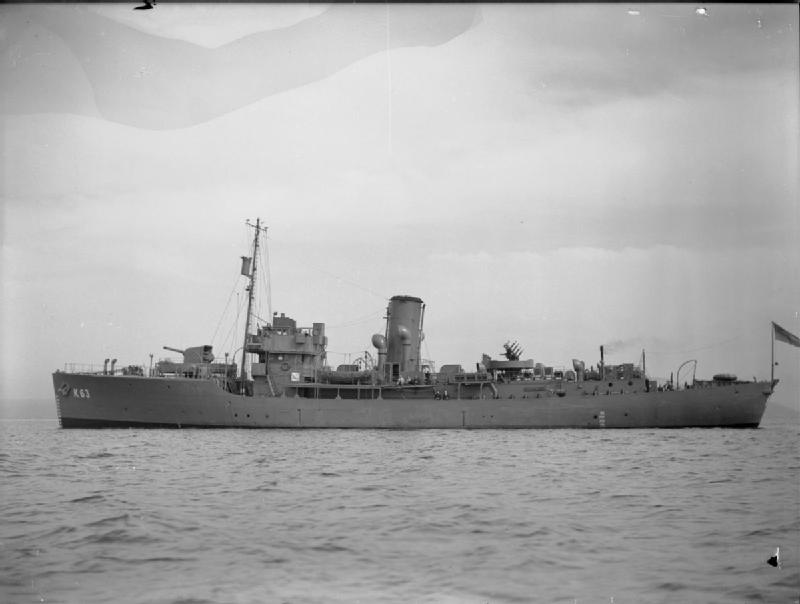
Royal Navy Flower-class corvette HMS Picotee, pennant K63, shortly after being commissioned before modification, showing a number of original design features, including a much shorter bow and forecastle and a mast in front of the bridge, although the second mast has been removed.
Imperial War Museum photo by Lt. H.W. Tomlin, Royal Navy official photographer, via Wikimedia Commons.
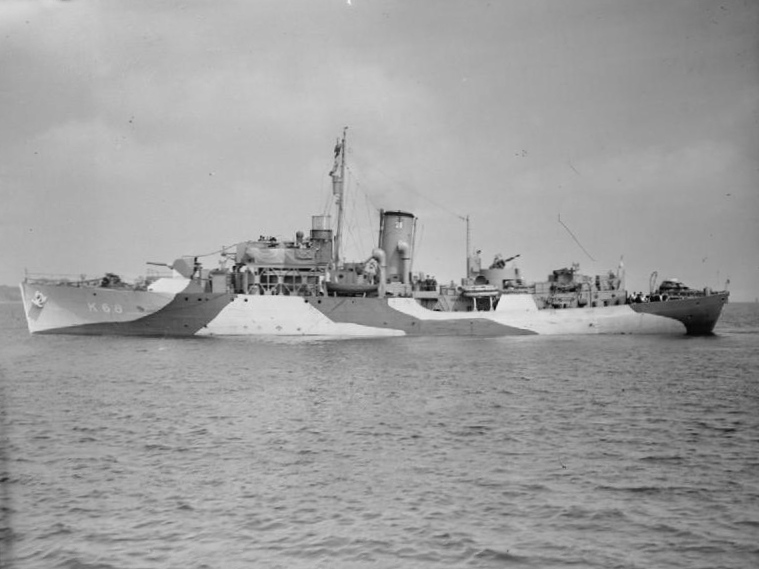
Royal Navy Flower-class corvette HMS Jonquil later in the war showing the changes to the bow and forecastle.
Imperial War Museum photograph FL 22394, via Wikimedia Commons.
Terrence Robertson described for Maclean’s the first time he saw a RCN corvette at sea:
She was Canadian-built, Canadian-manned and named Windflower (incidentally one of the ten built for British use, then “returned” to the RCN). When the destroyer on which I was serving met this newcomer to the Atlantic battlefield in January 1941, we not unnaturally approached for a closer look. We saw on her foredeck a four-inch gun with a wooden barrel that drooped. Then we were warned to keep clear of her stern with the immortal signal: “If you touch me there, I’ll scream.”
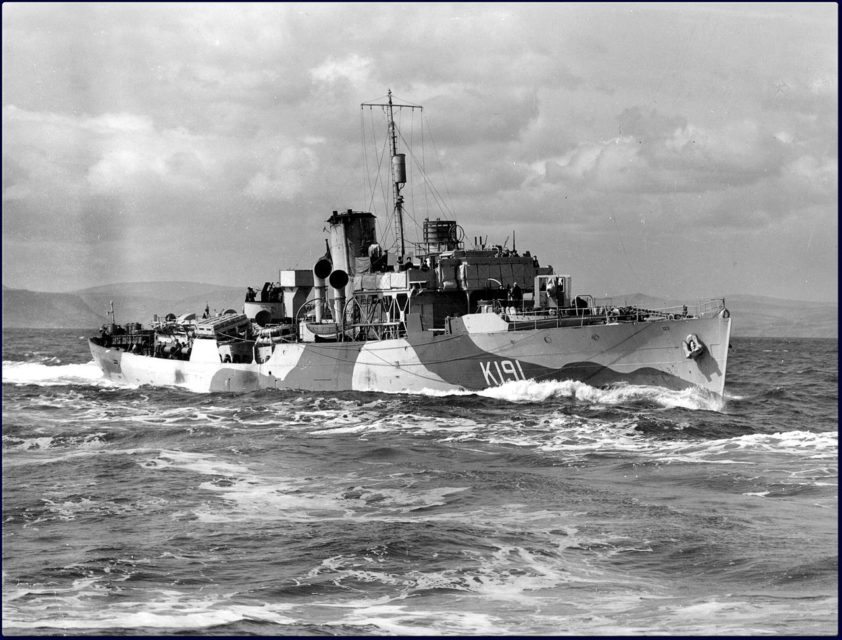
HMCS Mayflower in 1942, one of the first ten corvettes built in Canada like her sister Windflower.
Photo from the Canadian Navy Heritage website, Image Negative Number MC-2589, via Wikimedia Commons.
Marc Milner continues:
The ten British corvettes were the second group of ships thrust upon a reluctant RCN by the British in less than a year. By RN standards the manpower requirements for the sixteen ships was not very large (about 1200 all ranks), but their acquisition represented a major expansion for the RCN. The means whereby the corvettes came into Canadian service also illustrates what was for the RCN a recurrent problem, that of obtaining the release of both men and ships lent to the RN. The first incident may well have been an absent-minded assumption on the part of many British officers that the RCN was committed to some form of Commonwealth navy. … In the event, the RCN put up an honourable fight, better than any of its later attempts. But once committed to the common cause, it had little choice but to turn in the direction where the powers that be deemed its efforts would achieve the most good. Perhaps more serious, with respect to the pending struggle for efficiency in the RCN’s own corvette fleet, was the Admiralty’s insistence that the Canadian navy could accept a delay in developing that efficiency. Ironically, a few short weeks later the British urgently requested that RCN corvettes be committed to convoy operations in the Northwest Atlantic. If Canada’s naval expansion seemed to lack direction, it is small wonder.
Provision of officers and men for the navy’s new ships was of course a primary concern as 1940 drew to a close. Much of the RCN’s disposable manpower went into commissioning the six Town class destroyers and ten corvettes taken over from the Admiralty — sixteen warships for which the navy had made no provision mere months before. Naturally this meant that the planning and assignment of personnel for the first wave of RCN corvettes was set back. Further, with virtually the whole fleet on active duty on the other side of the Atlantic, the navy had no ongoing access either to experienced personnel or to berths on operational warships which could serve as training posts for new officers and key non-substantive ratings. With proper management (by no means guaranteed), a modest interchange of new drafts and experienced personnel would have permitted a more orderly expansion of the fleet and shore establishments and would have softened the devastating impact of expansion in 1941. The navy considered this problem, and the Staff discussed the possibility of routing the occasional destroyer to a Canadian port where personnel could be exchanged. But the Naval Staff concluded that “it would be a most unwise policy to relieve any large percentage of a ship’s company when that vessel was acting in a War Zone.”
The first RCN corvettes to become operational therefore were commissioned with scratch crews. Although the navy kept its sound policy of not tampering with escorts in a war zone, the conditions which obtained over the winter of 1940-1 changed by the following spring. By then the fleet was operational closer to home and, technically at least, no longer in a war zone.
In late 1940 the RCN was faced with building up manpower needed to commission fifty-four corvettes, twenty-five minesweepers, and small numbers of motor launches — about seven thousand officers and men.
Windflower and Mayflower were the first two Canadian-built corvettes to make the passage to England. The navy was short of suitable weapons, so both had been fitted with dummy guns. The irrepressible pair were the first two of an eventual one hundred and twenty-two corvettes which, in the next four years, would carry thousands of pre-war farmers, miners, students, and white-collar workers into battle against the U-boat fleet. Their exploits were rarely spectacular, almost never heroic. But in the Battle of the Atlantic, the words “Canadian” and “corvette” became almost synonymous and the little ships created legends of courage and endurance.
They were needed more and more with each passing month. During the last week of February 1941, 150,000 tons of Allied merchant shipping was sunk; in the first two weeks of March, 245,000 tons; and this rate of loss continued into April and May. Three or four ships and their cargoes were being sunk daily.

